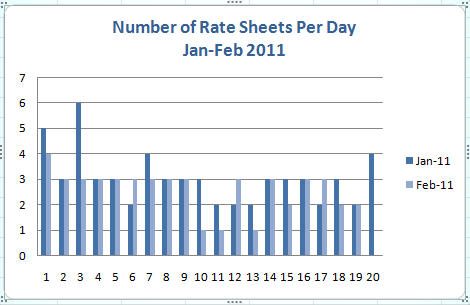
As much as I want the economy to improve (hint – just as much as you do, I promise, and I do believe it will) I have deep concern about the employment outlook. If the markets wish to interpret this as significant momentum in the labor markets, it certainly helps set the tone for tomorrow’s big release, the February Jobs Report.
With the data received the past two days, and the fact that the bond market has just stalled out after a two week rally, the safe bet is to lock your loan here, today. The Jobs Report will be old news in the bond markets by the time most people in the Bay Area wake up tomorrow.
Wah-waaaa… (insert rant)
I hate to get all Debbie Downer here, but I am not as comforted by the jobs data. Yes, great that the hemorrhaging has stopped. US corporations have already cut to gristle, are operating on lean and mean budgets, and sitting on cash. The President recently asked businesses to spend some money on growing their businesses, and the free markets camp laughed in his face. Politics aside, it sheds light on pro-business mentality. The private sector is where the hiring needs to happen.
Have you seen the chart showing the scope of jobs lost during this Great Recession, and the time lapsed while the labor market attempts to recover? Allow me… We are deep inside the belly of this beast. If the economy is a ship on the verge of sinking, 180k new jobs (tomorrow’s forecast) hardly bails out the water that came on board since the last report. It’s going to take a very loooong time to dry out creating jobs at this pace.
I fear a turbulent, undulating ground beneath a thin stable layer on the surface of this economy. People get tired of being down, of not spending, of cutting budgets over and over. When this happens, collectively, we get a string of less negative data in retail spending, things like that. Enough of these reports, and people might think we’re crawling out of this mess. And the funny thing is, if everybody think’s we’re crawling out of this mess, they’ll really start spending money again, and companies will start hiring again, and we’ll crawl out of the mess. But we can’t go spending money we don’t have. That’s how we created the mess. False confidence. We have to earn it, and we’re still repairing the damage done from the last time.
Let’s get back to the Jobs Report
Are you working on a purchase or refinance transaction? Simply put, I think there is more risk in floating than in locking into tomorrow’s February payroll and unemployment data, aka ‘The Jobs Report’.
Mortgage rates are heavily influenced right now by jobs data, the pace of new job creation being a key indicator of economic growth prospects. The more jobs created, and the lower the unemployment rate, the better the economic outlook, and the higher rates will head. Too few jobs created, and bond markets have fuel to rally, and rates should move lower.
Conditions Heading Into The Jobs Report
On Wednesday, ADP released it’s February report. This one is the precursor to the Bureau of Labor Statistics report. It showed 217k new jobs in February. Economists estimate that roughly 125k-150k new people enter the job market each month, as graduates, immigrants, etc. So the 217k new jobs represented about 80k jobs for previously unemployed people. This is not inspiring job growth. Bond markets didn’t find it too eventful either way, and rates moved slightly lower on the day.
The Bottom Line
After a period of increasing economic optimism, like kryptonite for the bond market, we’ve just seen two full weeks of bond market rally, causing rates to grind lower. Two weeks is a long time to go in one direction only, and at some point, the direction must be questioned, tested, corrected. Heading in to tomorrow’s February Jobs Report, a correction has already begun. There’s a bias in the direction of higher rates, and I think it will take a huge miss on the headline number tomorrow to cause bonds to rally.
I see three basic outcomes to the report tomorrow:
- Strong report; rates higher
- Report matches expectations; rates higher on ‘confirmation’ of belief
- Weak report; rates moderately lower
As was the case last month, I think it will take a real disaster of a report to pull rates lower. The turmoil in the Middle East has helped shake up the recent string of confidence-building economic reports, but Wednesday’s ADP report and today’s continuing claims report indicate tomorrow’s data will have the material for a positive spin. Again, a mildly strong report could be all it takes to bump rates into then next updraft. The sensitivity remains in that direction.
Of course, I could be totally wrong. But why risk it? Rates are right near their historical lows, money is cheap. Don’t let it slip out of your hands. Play this one safe.
If you feel like you could use some help navigating your upcoming refinance or purchase transaction against the trickle of economic data points, contact me and let me know about it.






